2008 AUDI S5 oil temperature
[x] Cancel search: oil temperaturePage 14 of 294
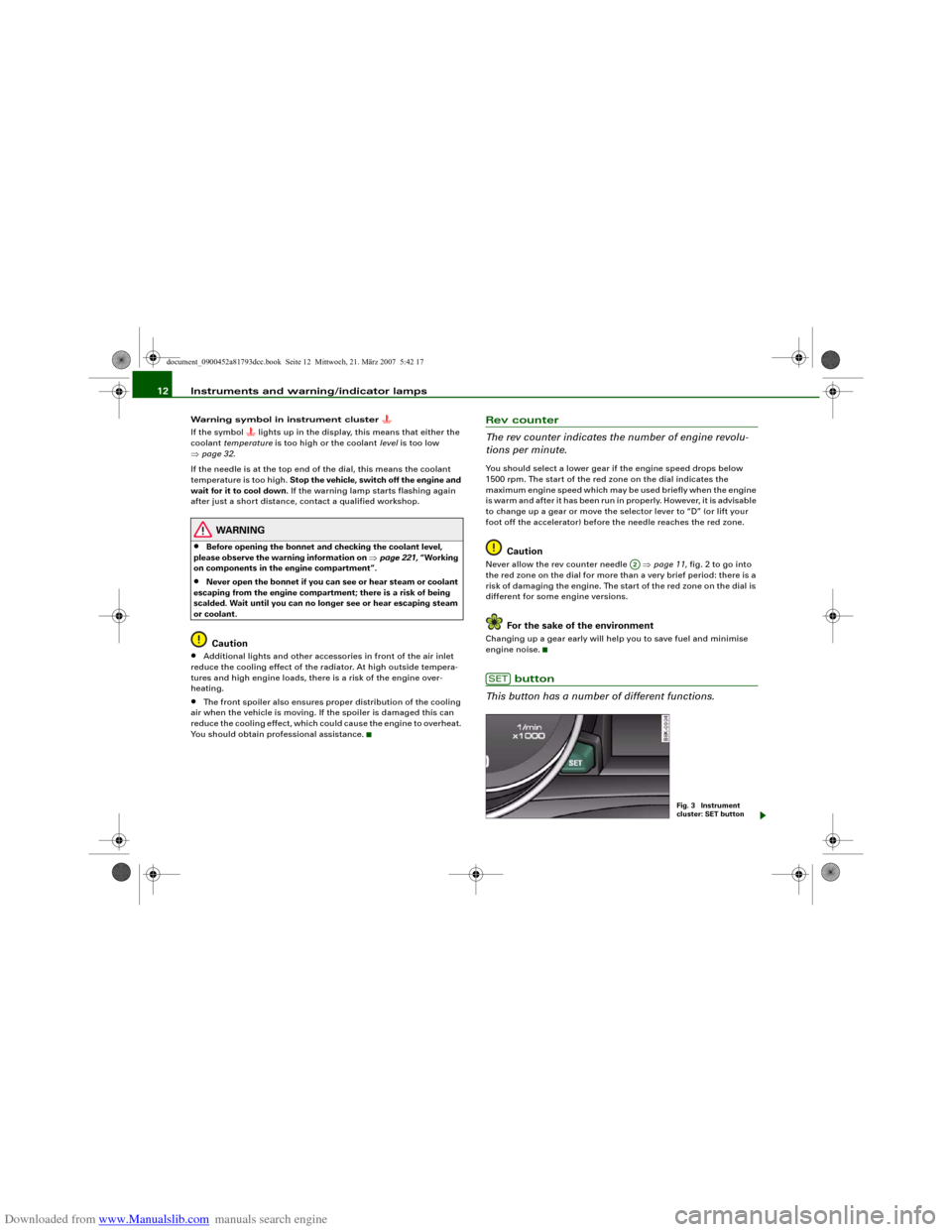
Downloaded from www.Manualslib.com manuals search engine Instruments and warning/indicator lamps 12Warning symbol in instrument cluster
If the symbol
lights up in the display, this means that either the
coolant temperature is too high or the coolant level is too low
⇒page 32.
If the needle is at the top end of the dial, this means the coolant
temperature is too high. Stop the vehicle, switch off the engine and
wait for it to cool down. If the warning lamp starts flashing again
after just a short distance, contact a qualified workshop.
WARNING
•
Before opening the bonnet and checking the coolant level,
please observe the warning information on ⇒page 221, “Working
on components in the engine compartment”.
•
Never open the bonnet if you can see or hear steam or coolant
escaping from the engine compartment; there is a risk of being
scalded. Wait until you can no longer see or hear escaping steam
or coolant.Caution
•
Additional lights and other accessories in front of the air inlet
reduce the cooling effect of the radiator. At high outside tempera-
tures and high engine loads, there is a risk of the engine over-
heating.
•
The front spoiler also ensures proper distribution of the cooling
air when the vehicle is moving. If the spoiler is damaged this can
reduce the cooling effect, which could cause the engine to overheat.
You should obtain professional assistance.
Rev counter
The rev counter indicates the number of engine revolu-
tions per minute.You should select a lower gear if the engine speed drops below
1500 rpm. The start of the red zone on the dial indicates the
maximum engine speed which may be used briefly when the engine
is warm and after it has been run in properly. However, it is advisable
to change up a gear or move the selector lever to “D” (or lift your
foot off the accelerator) before the needle reaches the red zone.
Caution
Never allow the rev counter needle ⇒page 11, fig. 2 to go into
the red zone on the dial for more than a very brief period: there is a
risk of damaging the engine. The start of the red zone on the dial is
different for some engine versions.
For the sake of the environment
Changing up a gear early will help you to save fuel and minimise
engine noise.
button
This button has a number of different functions.
A2
SET
Fig. 3 Instrument
cluster: SET button
document_0900452a81793dcc.book Seite 12 Mittwoch, 21. März 2007 5:42 17
Page 33 of 294

Downloaded from www.Manualslib.com manuals search engine Driver information system31
Controls
Safety
Driving tips
General maintenance
Self-help
Technical data
– Switch off the engine.
– Check the function displayed. Obtain professional assist-
ance if necessary.The red symbols indicate a Priority 1 fault (serious malfunction).
Should a Priority 1 fault occur, a red warning symbol will appear at
the top of the display ⇒page 30, fig. 25. The symbol is accompa-
nied by a driver message giving you more information about the
fault. This symbol is accompanied by three warning chimes. The
symbol will keep flashing until the fault is corrected.
If several Priority 1 faults are detected at the same time, the symbols
are displayed one after the other for about 2 seconds at a time.
This message will disappear after about 5 seconds, but you can call
it up again at any time by pressing the button ⇒page 30.Alternator fault
If the symbol
flashes in the instrument cluster display, there is an
alternator fault or a fault in the vehicle's electrical system. In addi-
tion, a message will appear. This message will disappear after about 5 seconds, but you can call it up again at any time by pressing the
button.
You should normally be able to drive to the next available qualified
workshop. However, you should avoid using electrical equipment
that is not absolutely necessary because this will drain the battery.
Caution
If the coolant warning lamp
in the instrument display lights up
as well as the alternator warning lamp while driving ⇒page 32, stop
the vehicle immediately and switch off the engine. In this case the
coolant pump is no longer being driven, and there is a risk of engine
damage.
Fault in the brake system
A fault in the brake system should be corrected as soon as
possible.If the symbol
flashes in the display, there is a fault in the
brake system. The symbol is accompanied by a driver
message giving you more information about the fault. This
message will disappear after about 5 seconds, but you can
call it up again at any time by pressing the button:
Stop vehicle and check brake fluid level
– Stop the vehicle.
– Check the brake fluid level ⇒page 227.
– Obtain professional assistance if necessary.
Warning! Fault in ABS brake system. Contact
workshop
– Drive carefully to the nearest qualified workshop and
have the fault rectified ⇒.
Alternator fault
⇒page 31
Fault in brake system/ parking
brake
⇒page 31
Coolant level too low / coolant
temperature too high
⇒page 32
Engine oil pressure too low
⇒page 33
Fault in the steering system
⇒page 33
Ignition lock defective
⇒page 34
SET
SET
SET
document_0900452a81793dcc.book Seite 31 Mittwoch, 21. März 2007 5:42 17
Page 117 of 294
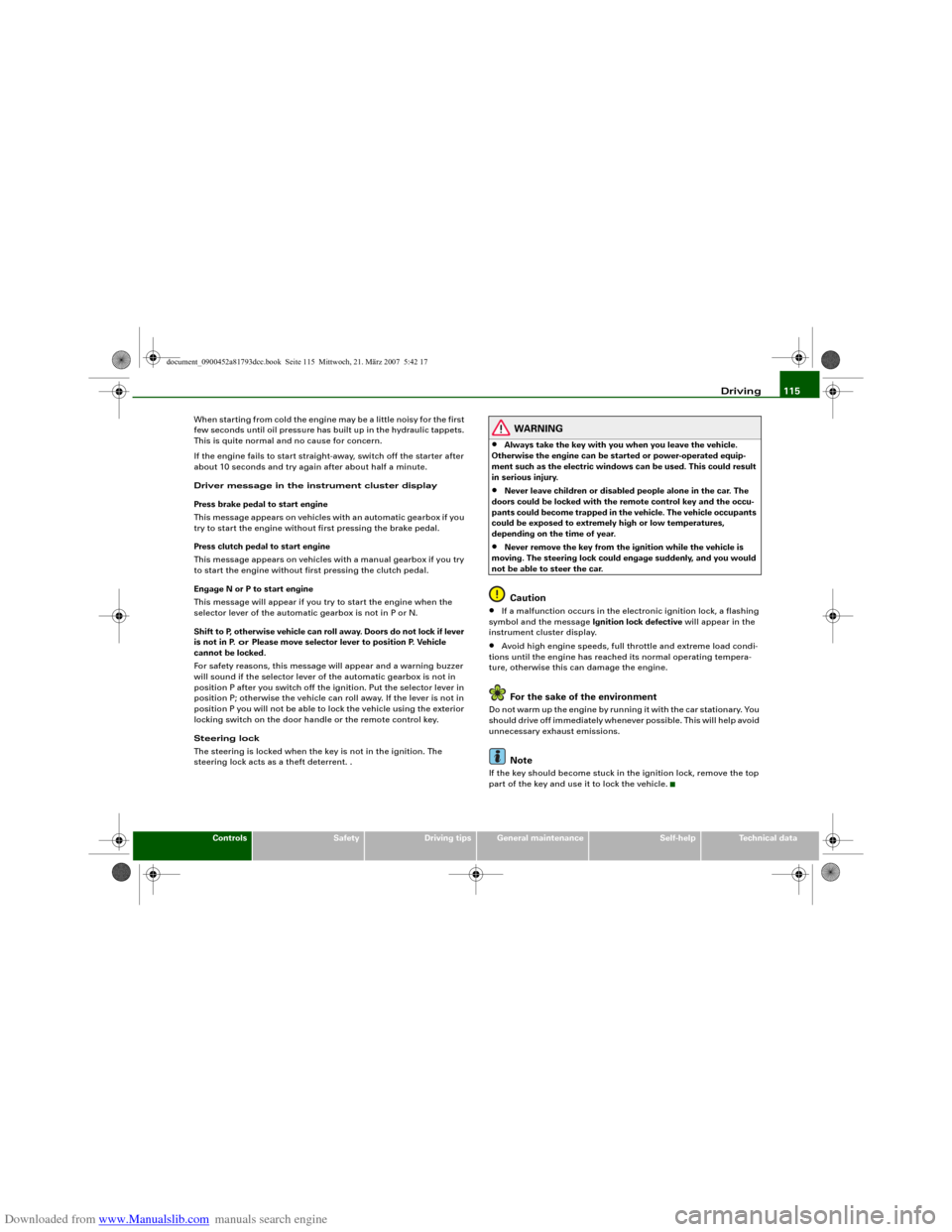
Downloaded from www.Manualslib.com manuals search engine Driving115
Controls
Safety
Driving tips
General maintenance
Self-help
Technical data When starting from cold the engine may be a little noisy for the first
few seconds until oil pressure has built up in the hydraulic tappets.
This is quite normal and no cause for concern.
If the engine fails to start straight-away, switch off the starter after
about 10 seconds and try again after about half a minute.
Driver message in the instrument cluster display
Press brake pedal to start engine
This message appears on vehicles with an automatic gearbox if you
try to start the engine without first pressing the brake pedal.
Press clutch pedal to start engine
This message appears on vehicles with a manual gearbox if you try
to start the engine without first pressing the clutch pedal.
Engage N or P to start engine
This message will appear if you try to start the engine when the
selector lever of the automatic gearbox is not in P or N.
Shift to P, otherwise vehicle can roll away. Doors do not lock if lever
is not in P. or Please move selector lever to position P. Vehicle
cannot be locked.
For safety reasons, this message will appear and a warning buzzer
will sound if the selector lever of the automatic gearbox is not in
position P after you switch off the ignition. Put the selector lever in
position P; otherwise the vehicle can roll away. If the lever is not in
position P you will not be able to lock the vehicle using the exterior
locking switch on the door handle or the remote control key.
Steering lock
The steering is locked when the key is not in the ignition. The
steering lock acts as a theft deterrent. .
WARNING
•
Always take the key with you when you leave the vehicle.
Otherwise the engine can be started or power-operated equip-
ment such as the electric windows can be used. This could result
in serious injury.
•
Never leave children or disabled people alone in the car. The
doors could be locked with the remote control key and the occu-
pants could become trapped in the vehicle. The vehicle occupants
could be exposed to extremely high or low temperatures,
depending on the time of year.
•
Never remove the key from the ignition while the vehicle is
moving. The steering lock could engage suddenly, and you would
not be able to steer the car.Caution
•
If a malfunction occurs in the electronic ignition lock, a flashing
symbol and the message Ignition lock defective will appear in the
instrument cluster display.
•
Avoid high engine speeds, full throttle and extreme load condi-
tions until the engine has reached its normal operating tempera-
ture, otherwise this can damage the engine.For the sake of the environment
Do not warm up the engine by running it with the car stationary. You
should drive off immediately whenever possible. This will help avoid
unnecessary exhaust emissions.
Note
If the key should become stuck in the ignition lock, remove the top
part of the key and use it to lock the vehicle.
document_0900452a81793dcc.book Seite 115 Mittwoch, 21. März 2007 5:42 17
Page 212 of 294
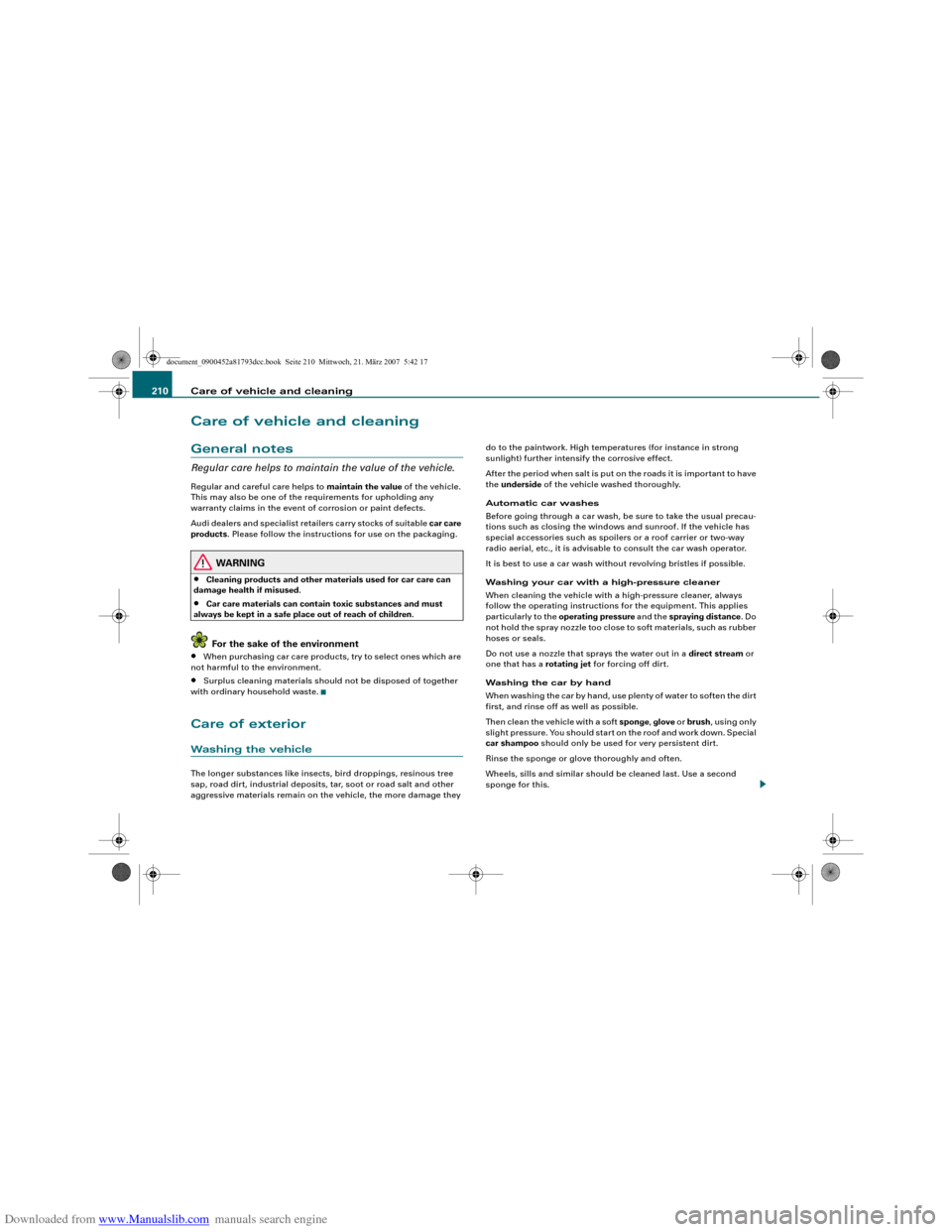
Downloaded from www.Manualslib.com manuals search engine Care of vehicle and cleaning 210Care of vehicle and cleaningGeneral notesRegular care helps to maintain the value of the vehicle.Regular and careful care helps to maintain the value of the vehicle.
This may also be one of the requirements for upholding any
warranty claims in the event of corrosion or paint defects.
Audi dealers and specialist retailers carry stocks of suitable car care
products. Please follow the instructions for use on the packaging.
WARNING
•
Cleaning products and other materials used for car care can
damage health if misused.
•
Car care materials can contain toxic substances and must
always be kept in a safe place out of reach of children.For the sake of the environment
•
When purchasing car care products, try to select ones which are
not harmful to the environment.
•
Surplus cleaning materials should not be disposed of together
with ordinary household waste.
Care of exteriorWa s hi ng t he ve hi c l eThe longer substances like insects, bird droppings, resinous tree
sap, road dirt, industrial deposits, tar, soot or road salt and other
aggressive materials remain on the vehicle, the more damage they do to the paintwork. High temperatures (for instance in strong
sunlight) further intensify the corrosive effect.
After the period when salt is put on the roads it is important to have
the underside of the vehicle washed thoroughly.
Automatic car washes
Before going through a car wash, be sure to take the usual precau-
tions such as closing the windows and sunroof. If the vehicle has
special accessories such as spoilers or a roof carrier or two-way
radio aerial, etc., it is advisable to consult the car wash operator.
It is best to use a car wash without revolving bristles if possible.
Washing your car with a high-pressure cleaner
When cleaning the vehicle with a high-pressure cleaner, always
follow the operating instructions for the equipment. This applies
particularly to the operating pressure and the spraying distance. Do
not hold the spray nozzle too close to soft materials, such as rubber
hoses or seals.
Do not use a nozzle that sprays the water out in a direct stream or
one that has a rotating jet for forcing off dirt.
Washing the car by hand
When washing the car by hand, use plenty of water to soften the dirt
first, and rinse off as well as possible.
Then clean the vehicle with a soft sponge, glove or brush, using only
slight pressure. You should start on the roof and work down. Special
car shampoo should only be used for very persistent dirt.
Rinse the sponge or glove thoroughly and often.
Wheels, sills and similar should be cleaned last. Use a second
sponge for this.
document_0900452a81793dcc.book Seite 210 Mittwoch, 21. März 2007 5:42 17
Page 250 of 294
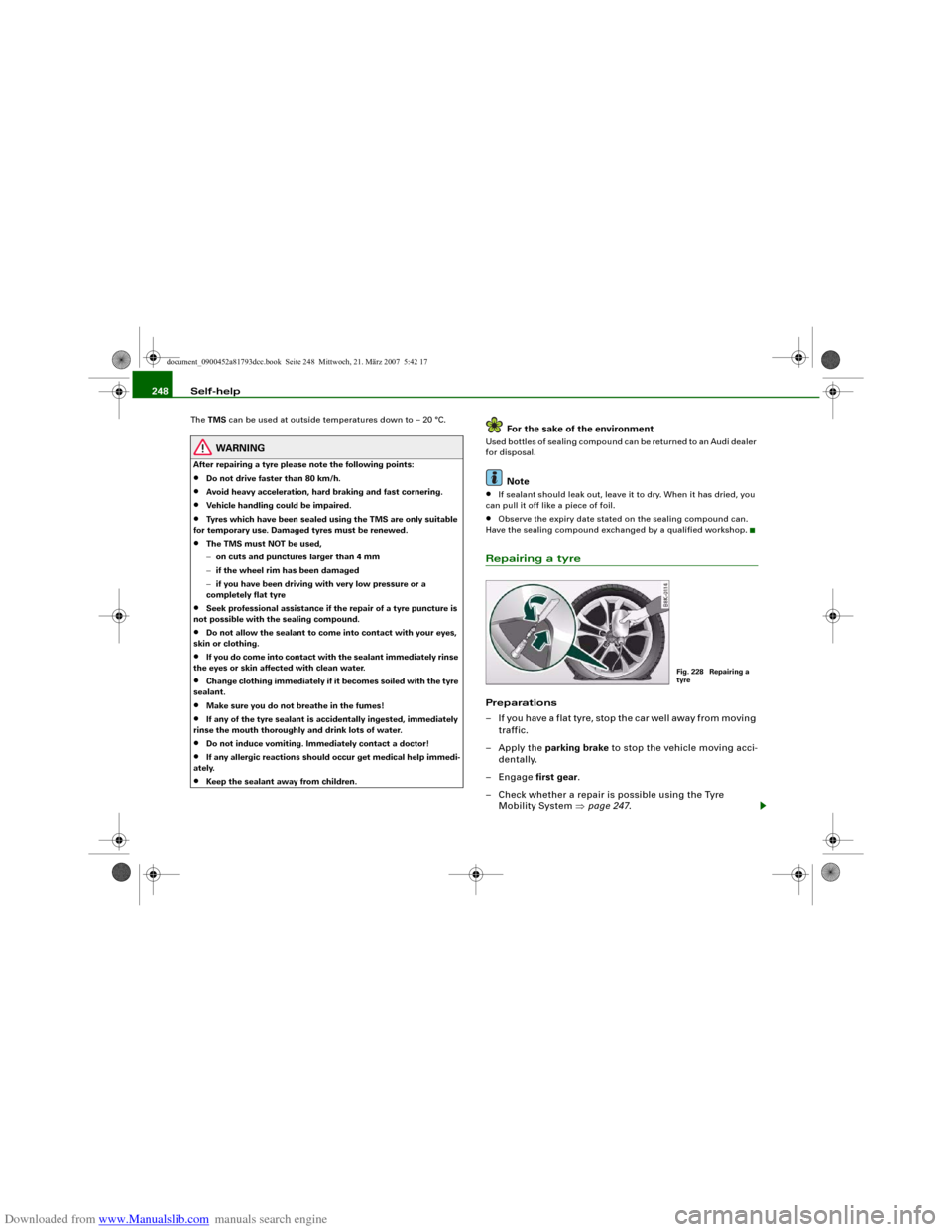
Downloaded from www.Manualslib.com manuals search engine Self-help 248The TMS can be used at outside temperatures down to – 20 °C.
WARNING
After repairing a tyre please note the following points:•
Do not drive faster than 80 km/h.
•
Avoid heavy acceleration, hard braking and fast cornering.
•
Vehicle handling could be impaired.
•
Tyres which have been sealed using the TMS are only suitable
for temporary use. Damaged tyres must be renewed.
•
The TMS must NOT be used,
−on cuts and punctures larger than 4 mm
−if the wheel rim has been damaged
−if you have been driving with very low pressure or a
completely flat tyre
•
Seek professional assistance if the repair of a tyre puncture is
not possible with the sealing compound.
•
Do not allow the sealant to come into contact with your eyes,
skin or clothing.
•
If you do come into contact with the sealant immediately rinse
the eyes or skin affected with clean water.
•
Change clothing immediately if it becomes soiled with the tyre
sealant.
•
Make sure you do not breathe in the fumes!
•
If any of the tyre sealant is accidentally ingested, immediately
rinse the mouth thoroughly and drink lots of water.
•
Do not induce vomiting. Immediately contact a doctor!
•
If any allergic reactions should occur get medical help immedi-
ately.
•
Keep the sealant away from children.
For the sake of the environment
Used bottles of sealing compound can be returned to an Audi dealer
for disposal.
Note
•
If sealant should leak out, leave it to dry. When it has dried, you
can pull it off like a piece of foil.
•
Observe the expiry date stated on the sealing compound can.
Have the sealing compound exchanged by a qualified workshop.
Repairing a tyrePreparations
– If you have a flat tyre, stop the car well away from moving
traffic.
– Apply the parking brake to stop the vehicle moving acci-
dentally.
–Engage first gear.
– Check whether a repair is possible using the Tyre
Mobility System ⇒page 247.
Fig. 228 Repairing a
tyre
document_0900452a81793dcc.book Seite 248 Mittwoch, 21. März 2007 5:42 17
Page 291 of 294
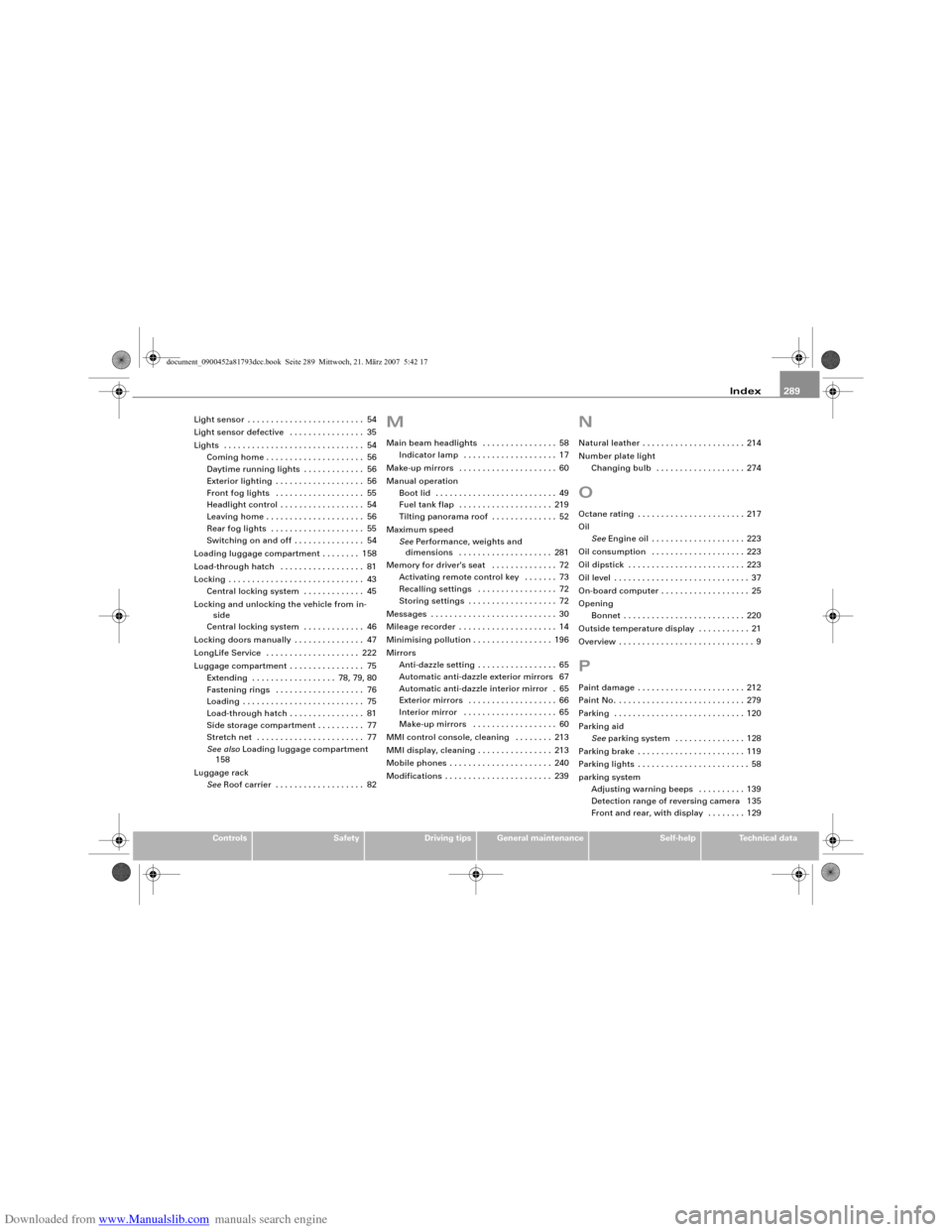
Downloaded from www.Manualslib.com manuals search engine Index289
Controls
Safety
Driving tips
General maintenance
Self-help
Technical data Light sensor . . . . . . . . . . . . . . . . . . . . . . . . . 54
Light sensor defective . . . . . . . . . . . . . . . . 35
Lights . . . . . . . . . . . . . . . . . . . . . . . . . . . . . . 54
Coming home . . . . . . . . . . . . . . . . . . . . . 56
Daytime running lights . . . . . . . . . . . . . 56
Exterior lighting . . . . . . . . . . . . . . . . . . . 56
Front fog lights . . . . . . . . . . . . . . . . . . . 55
Headlight control . . . . . . . . . . . . . . . . . . 54
Leaving home . . . . . . . . . . . . . . . . . . . . . 56
Rear fog lights . . . . . . . . . . . . . . . . . . . . 55
Switching on and off . . . . . . . . . . . . . . . 54
Loading luggage compartment . . . . . . . . 158
Load-through hatch . . . . . . . . . . . . . . . . . . 81
Locking . . . . . . . . . . . . . . . . . . . . . . . . . . . . . 43
Central locking system . . . . . . . . . . . . . 45
Locking and unlocking the vehicle from in-
side
Central locking system . . . . . . . . . . . . . 46
Locking doors manually . . . . . . . . . . . . . . . 47
LongLife Service . . . . . . . . . . . . . . . . . . . . 222
Luggage compartment . . . . . . . . . . . . . . . . 75
Extending . . . . . . . . . . . . . . . . . . 78, 79, 80
Fastening rings . . . . . . . . . . . . . . . . . . . 76
Loading . . . . . . . . . . . . . . . . . . . . . . . . . . 75
Load-through hatch . . . . . . . . . . . . . . . . 81
Side storage compartment . . . . . . . . . . 77
Stretch net . . . . . . . . . . . . . . . . . . . . . . . 77
See alsoLoading luggage compartment
158
Luggage rack
SeeRoof carrier . . . . . . . . . . . . . . . . . . . 82
MMain beam headlights . . . . . . . . . . . . . . . . 58
Indicator lamp . . . . . . . . . . . . . . . . . . . . 17
Make-up mirrors . . . . . . . . . . . . . . . . . . . . . 60
Manual operation
Boot lid . . . . . . . . . . . . . . . . . . . . . . . . . . 49
Fuel tank flap . . . . . . . . . . . . . . . . . . . . 219
Tilting panorama roof . . . . . . . . . . . . . . 52
Maximum speed
SeePerformance, weights and
dimensions . . . . . . . . . . . . . . . . . . . . 281
Memory for driver's seat . . . . . . . . . . . . . . 72
Activating remote control key . . . . . . . 73
Recalling settings . . . . . . . . . . . . . . . . . 72
Storing settings . . . . . . . . . . . . . . . . . . . 72
Messages . . . . . . . . . . . . . . . . . . . . . . . . . . . 30
Mileage recorder . . . . . . . . . . . . . . . . . . . . . 14
Minimising pollution . . . . . . . . . . . . . . . . . 196
Mirrors
Anti-dazzle setting . . . . . . . . . . . . . . . . . 65
Automatic anti-dazzle exterior mirrors 67
Automatic anti-dazzle interior mirror . 65
Exterior mirrors . . . . . . . . . . . . . . . . . . . 66
Interior mirror . . . . . . . . . . . . . . . . . . . . 65
Make-up mirrors . . . . . . . . . . . . . . . . . . 60
MMI control console, cleaning . . . . . . . . 213
MMI display, cleaning . . . . . . . . . . . . . . . . 213
Mobile phones . . . . . . . . . . . . . . . . . . . . . . 240
Modifications . . . . . . . . . . . . . . . . . . . . . . . 239
NNatural leather . . . . . . . . . . . . . . . . . . . . . . 214
Number plate light
Changing bulb . . . . . . . . . . . . . . . . . . . 274OOctane rating . . . . . . . . . . . . . . . . . . . . . . . 217
Oil
SeeEngine oil . . . . . . . . . . . . . . . . . . . . 223
Oil consumption . . . . . . . . . . . . . . . . . . . . 223
Oil dipstick . . . . . . . . . . . . . . . . . . . . . . . . . 223
Oil level . . . . . . . . . . . . . . . . . . . . . . . . . . . . . 37
On-board computer . . . . . . . . . . . . . . . . . . . 25
Opening
Bonnet . . . . . . . . . . . . . . . . . . . . . . . . . . 220
Outside temperature display . . . . . . . . . . . 21
Overview . . . . . . . . . . . . . . . . . . . . . . . . . . . . . 9PPaint damage . . . . . . . . . . . . . . . . . . . . . . . 212
Paint No. . . . . . . . . . . . . . . . . . . . . . . . . . . . 279
Parking . . . . . . . . . . . . . . . . . . . . . . . . . . . . 120
Parking aid
Seeparking system . . . . . . . . . . . . . . . 128
Parking brake . . . . . . . . . . . . . . . . . . . . . . . 119
Parking lights . . . . . . . . . . . . . . . . . . . . . . . . 58
parking system
Adjusting warning beeps . . . . . . . . . . 139
Detection range of reversing camera 135
Front and rear, with display . . . . . . . . 129
document_0900452a81793dcc.book Seite 289 Mittwoch, 21. März 2007 5:42 17